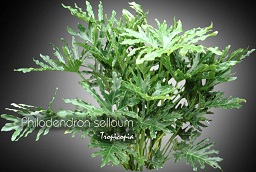Table of contents
Lacy tree-philodendron

Latin Name: Philodendron selloum
Category: Philodendron
Family: Araceae
Origin: Brazil
Climate: Tropical
Growing Zones: 11-10
Care Instructions
The Lacy tree-philodendron (Philodendron selloum) is a tropical plant that originates from Brazil. This philodendron plant belongs to the Araceae family and is well-suited for growing in USDA zones 11-10.
Complete Care Guide for Lacy Tree-Philodendron (Philodendron selloum)
Watering Requirements
The Lacy Tree-Philodendron, known scientifically as Philodendron selloum, thrives in a well-balanced watering routine. It is essential to keep the soil consistently moist but not soggy. Water the plant when the top inch of the soil feels dry to the touch. During the growing season, typically spring and summer, you may need to water more frequently, approximately once a week. In the fall and winter months, reduce watering to every two weeks, as the plant enters a dormant phase. Overwatering can lead to root rot, so ensure that the pot has adequate drainage and avoid letting the plant sit in standing water.
Light Conditions
Philodendron selloum prefers bright, indirect light but can tolerate lower light conditions. Ideally, place your Lacy Tree-Philodendron near a window that receives filtered sunlight. Direct sunlight can scorch the leaves, leading to brown tips and edges. If you notice the plant becoming leggy or the leaves losing their vibrant color, it may be a sign that it needs more light. Conversely, if the leaves are turning yellow, it could indicate too much direct sunlight. For optimal growth, aim for a balance of light that mimics its natural tropical habitat.
Soil Preferences
The ideal soil for Lacy Tree-Philodendron is a well-draining potting mix that retains some moisture without becoming waterlogged. A blend of peat moss, perlite, and pine bark works well, providing the necessary aeration and drainage. It is also beneficial to incorporate organic matter, such as compost, to enhance soil fertility. Fertilization should occur during the growing season with a balanced, water-soluble fertilizer every 4-6 weeks. In the fall and winter, reduce or eliminate fertilization as the plant’s growth slows down.
Pests and Diseases
Common pests that may affect Philodendron selloum include spider mites, aphids, and mealybugs. Regularly inspect the undersides of leaves and stems for signs of infestation. If you notice any pests, treat them promptly with insecticidal soap or neem oil. Additionally, the Lacy Tree-Philodendron can be susceptible to fungal diseases, particularly if overwatered. Signs of disease include yellowing leaves and a mushy stem. To prevent these issues, ensure proper watering practices and good air circulation around the plant. If disease occurs, remove affected leaves and adjust care accordingly.
Special Care Tips
To keep your Lacy Tree-Philodendron healthy and thriving, consider the following special care tips: First, regularly wipe the leaves with a damp cloth to remove dust, which can hinder photosynthesis. This also helps to keep the plant looking vibrant and lush. Second, if you notice the plant becoming too large for its pot, consider repotting it every couple of years to provide fresh soil and more space for growth. Lastly, be mindful of temperature; Philodendron selloum prefers temperatures between 65°F and 80°F (18°C to 27°C) and should be protected from cold drafts and sudden temperature changes. With these care tips, your Lacy Tree-Philodendron will flourish and become a stunning focal point in your home or garden.








